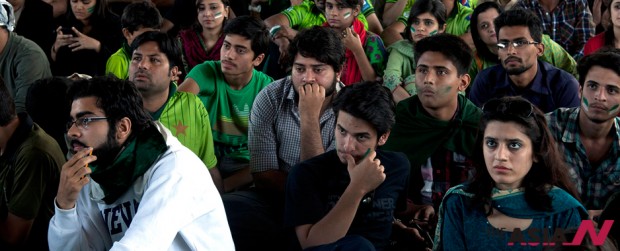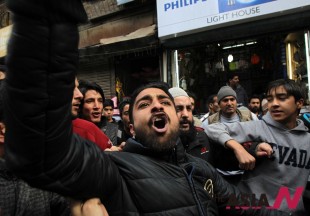Pakistan-India Cricket Diplomacy

Pakistani cricket fans watch the cricket World Cup Pool B match between Pakistan and India on a big screen in the neighborhood of Karachi, Pakistan, Sunday, Feb. 15, 2015. India continue its World Cup domination of archival Pakistan, extending its winning streak to six with a lopsided 76-run victory. (Photo : AP)
Batting for the Peace: Does it really work?
Cricket, one of the widely played games in the world, is highly popular in most populous nations of South Asia like India, Pakistan and Bangladesh where the people hailing from all age groups are over-enthusiastic about it. Even the people, who had never played the cricket in their life, become so excited when they watch the live telecast of the cricket played anywhere in the world. The women too, especially the young and the teenagers know the names of world players very well and use to chat about them often as if they were their close neighbors. But the excitement of the people living on either side of border shoots up further turning into frenzy when Pakistan and Indian teams encounter heating up the atmosphere as if the war was being fought between the two arch-rival nations at the cricket pitch.
The cricket and other sports activities are supposed to ease the tensions at borders as well as at government level between two nations but the India-Pakistan cricket rivalry, known as one of the most intense sports rivalries in the world, shadow all such objectives. The spectators at the stadiums as well as the millions of viewers watching the live telecast appear as two nations having old enmity. Whenever the two countries encounter at cricket field, it attracts approximately one billion viewers, according to TV rating firms and various other reports. The 2011 World Cup Semifinal between the two countries had attracted 988 million television viewers.

Supporters of pro-independent group Jammu and Kashmir Liberation Front (JKLF) shout slogans during a protest against the expulsion of Kashmiri students by an Indian university in Srinagar, summer capital
of Indian-controlled Kashmir, March 7, 2014. (Photo : Xinhua)
The emergence of sporting rivalry among them is the result of communal violence that marked the partition of British India into India and Pakistan in 1947 and subsequent Kashmir conflict between the two nations who fought two major wars – first in 1965 and the other in 1971.
The two nations share a common cricketing heritage, as it was introduced in Indian subcontinent by the East India Company. Many of the players in the first post-independence teams of India and Pakistan had played together as team-mates in regional and local tournaments. Some of the cricketers played in British Indian team but later stood divided like the partition of Indian subcontinent. Although, Pakistan was created in 1947, a cricketer Gul Muhammad continued to represent India until 1955 playing for India against Pakistan during Pakistan’s first tour of India in 1952. Similarly, another cricketer Aamir Ali played for India against Australia in Sydney in 1947 while Abdul Hafeez Kardar played for India from 1946 to 1948.
Their teams encountered first time in 1952, when the Pakistan toured India to play first Test series. The Indian team toured Pakistan for the first time in 1955 and later no cricket was played by two countries from 1962 to 1977. Despite common cricket heritage, players in both teams routinely face intense pressure to win, and are threatened by extreme reactions in defeat instead of showing sportsman spirit. Extreme fan reactions to defeats in key matches have been witnessed, with a limited degree of violence and public disturbances. Pakistan became permanent member of the International Cricket Council in 1948, and their tour of India was the first in Test cricket history. They lost the first Test in Delhi to India, but won the second Test in Lucknow, which led to an angry reaction from home crowd against the Indian players. India clinched the Test series after winning the third Test in Bombay (Mumbai) but the intense pressure affected the players of both teams to the point that they pursued mainly defensive tactics that led to drawn matches and whole series without a victor. When India toured Pakistan in 1955, thousands of Indian fans were granted visas to visit Pakistan city Lahore to witness the Test match. Pakistan again toured India in 1961 however both the series ended in draw with no test yielding a winner or loser.
The Indo-Pakistan wars of 1965 and 1971 put a hold on cricket between two countries that lasted till 1978 when it resumed for a brief period during the military regime in Pakistan. In the post-1971 period, politics became a direct factor in the holding of cricketing events. India had suspended cricketing ties with Pakistan several times due to hostilities. The resumption of cricketing ties took place in 1978, surprisingly, when a military dictator Gen. Zia-ul-Haq headed the regime in Pakistan. It was the time when the ‘Cricket Diplomacy’ was used to normalize the relations between two rival nations.
Shortly after the War Games, Pakistan President Gen. Zia was invited by India to watch India-Pakistan Test Match being played in Indian city Jaipur. Such form of diplomacy was used several times later. Pakistan toured India in 1979 but an Indian tour of Pakistan was cancelled mid-way due to assassination of Indian Prime Minister Mrs. Indira Gandhi in 1984. The term cricket diplomacy was born in 1987 when Pakistan’s military ruler Gen. Zia made an un-expected visit to India to watch cricket, which helped to defuse the potentially explosive situation.
In the late 1980s and for most of the 1990s, India and Pakistan squared off on neutral venues such as Sharjah in United Arab Emirates and Toronto, Canada. The series between two teams in Canada played in 1990s and early 2000 were officially known as the ‘Friendship Cup’. The rise of multinational competitions like Cricket World Cup, ICC World Twenty20, the Austral-Asia Cup and the Asia Cup led to more regular albeit briefer contests between them.
In 1999, immediately following the Indian Prime Minister Atal Bihari Vajpayee’s historic visit to Pakistan, the Pakistani team toured India for Test matches and played in an ODI before Kargil War again put bilateral relations in deep freeze. Vajpayee’s peace initiative led to India touring Pakistan after a gap of almost 15 years. Subsequent exchange tours were held in 2005 and 2006 before 2008 Mumbai terrorist attacks that led to suspension of India’s planned tour of Pakistan in 2009 and all future engagements in Pakistan. Earlier, another military dictator Gen. Pervez Musharraf visited India to watch cricket match as part of cricket diplomacy.
The rise of domestic terrorism led Pakistan not to host international cricket after an attack on Sri Lankan team in 2009 and the country was stripped of its co-host status for ICC Cricket World Cup 2011. However, two teams qualified for the first semi-final in Chandigrah and Indian government invited then Prime Minister of Pakistan Yousuf Raza Gilani to watch the match along with his counterpart Dr. Manmohan Singh. The bilateral ties between India and Pakistan resumed finally when BCCI invited Pakistan to tour India for three ODIs and two T20s in December 2012. The three ODIs were held in New Delhi, Kolkata and Chennai while Ahmadabad and Bangalore hosted two Twenty20 fixtures.
And very recent encounter between the two teams was in ICC Cricket World Cup 2015 wherein the India defeated Pakistan. And what was the reaction of Pakistan cricket fans? Angry, disappointed, dejected, furious and abusive – just some of the words to describe what they were feeling after ‘disappointing performance’, as they said, of their team. The selectors and players had been alleged of match-fixing like in the past. And what was the impact? Nothing but mistrust and ill-feeling!
The India-Pakistan cricket matches have offered opportunities for cricket diplomacy as means to improve relations between the two countries by allowing heads of state to exchange visits and cricket followers from either country to travel to the other to watch the matches, but the question is: Has cricket diplomacy between India and Pakistan been successful? Of course it eased tense relations temporarily but couldn’t proved effective tool for a stable peace between two rival nations although the cricket diplomacy has great potential.
Sports diplomacy has the potential to bring the people closer, bridge the differences, promote communication and understanding and not the least contribute to lasting peace, as the UN Secretary General’s 2006 report emphasizes, but for achieving all these goals we must consider it just sports and develop sportsman spirit. As far as Pakistan and India are concerned, Cricket Diplomacy is more relevant than ever and can play a greater role for lasting peace in the region by just changing our mindset. We must consider it ‘Batting for the Peace’ and not a ‘War at Cricket Pitch’.






























































